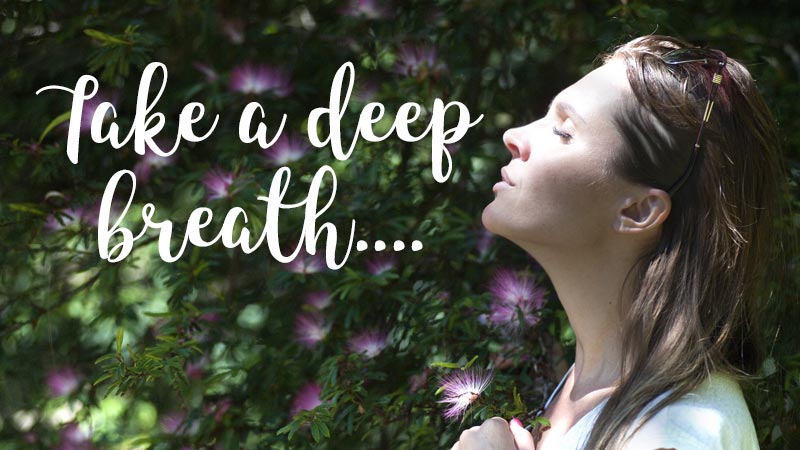
Just Take a Deep Breath: The Benefits of Breathing
“Just take a deep breath”. It’s a classical diversion tactic that’s used when things are about to get fraught or shouty. It’s like pressing pause and giving ourselves time to respond instead of wading on in there, letting our gut instincts take over and simply reacting to a situation. But instead of just standing there ‘pausing’, we can fill our time with an activity while we wait for the tidal wave of emotion to pass….Breathing.
In uncomfortable, stressful situations like this, deep, purposeful breathing or taking a long, slow breath isn’t just about filling time. There are many benefits of breathing (including the obvious).
Breathing actually has a powerful impact on our nervous system. When we get stressed or are exposed to pressure, urgency or indeed real danger, our Sympathetic Nervous System (SNS) takes control. It raises our heart rate, speeds up our breathing and releases stress hormones including adrenaline and cortisol.
This is the ‘fight or flight’ response that historically, would be necessary when running from danger. In today’s world, the fight or flight response is more likely to be activated by work stress, traffic jams, maybe naughty children or simply the pressure of life weighing on our shoulders.
The Relaxation Response
The Parasympathetic Nervous System (PNS) works to balance out the SNS; it slows the heart rate, lowers blood pressure and brings our breathing back to normal – it is our relaxation response. When we take long, deep breaths, the passageways in our lungs where the oxygen-carbon dioxide exchange takes place are enlarged. One of the PNS’s jobs is to bring these back to a ‘resting’ size, so by enlarging them consciously, we can activate the PNS.
With an activated PNS, a feeling of relaxation or calm dominates. So it makes sense to learn a technique that we can use to induce ‘relaxation’ whenever we feel ourselves becoming overwhelmed or stressed.
A Guide to Diaphragmatic Breathing
Below is a quick guide on how to master deep ‘diaphragmatic’ breathing. Dr Libby had some great advice about this in her latest book ‘Women’s Wellness Wisdom‘ and the guide below is an adaption of this with some helpful mindfulness tips included.
1. Find a quiet place and sit, stand or lie in a relaxed, comfortable position. Most breathing exercises recommend a sitting position, but I find standing can be better for posture and it helps with the opening up of the chest. Whatever position you choose, keep your back straight but relaxed.
2. You can close your eyes if this helps you focus but it’s not necessary. Gently place one hand on your tummy, and the other on your chest.
3. Be still and relax your body. Breathe normally and listen to the sound of your breath going in and out. Notice how it feels. Pay attention to how your hands move with your tummy and chest as you breathe. Continue for 10 breaths.
4. Now try to take a deeper breath in through your nose. Push the air into your tummy and feel your hand move outwards as you inhale. Imagine your tummy is a balloon and you are inflating it with your breath. This can be quite hard to do as many of us are accustomed to shallow breathing, which only takes air into the higher part of our chests. With a bit of practice, this will become easier.
5. Pause and gently push the air out of your tummy, exhaling though your nose.
6. Repeat these deep belly breaths 10 times.
Now…you might not experience instant, complete relaxation and total calm straight away. But do you feel a little less Gggrrrrrrr and a bit more AAaaahhhhh…??
Dr Libby notes that these exercises are nourishment for the nervous system and the more often you do them, the easier they will get. Just like anything.
Making it Part of Your Normal Day
To enjoy the benefits of breathing, don’t feel that you need to set aside a special time to do exercises. I know how easy it is to be put off doing things if we feel like we have to set aside extra time or make a particular effort.
Just use some spare moments in your day to take a few deep breaths. Perhaps while you are showering, breathe in the warm steam and enjoy the feeling of the water on your skin.
If you are overwhelmed with too many tasks, none of which are getting done, take a minute to breathe and then reassess the task list before making a plan based on priority; I do this a lot whilst at my desk! Or perhaps you’re waiting to collect the kids from school. Why not practice a few deep breaths before getting out of the car…?? It all helps.
Allow Yourself to Respond
For me, the benefits of breathing in this conscious, mindful way are most useful when I am IN a situation. When I can feel myself getting annoyed or stressed, my patience having been tested to the limit or my day just not going as planned.
I simply stop, and maybe close my eyes. I try to move on from the ‘thing’ that is annoying me and just focus on breathing. Deep, slow breaths.
I listen to each breath which helps me focus. I take notice of how it makes me feel. And I move on. Normally with a renewed sense of clarity about the situation and a calmness that helps me move forward with purpose.
I have given myself time to respond. And hopefully this results in a less shouty or bad tempered outcome than could have been the case if I’d just allowed my SNS to have its own sweet way.
So….next time someone says to you ‘Just take a deep breath’, give it a try!! It’s actually great advice and if you do it regularly, you’ll soon notice the benefits of breathing and be able to use your breath to trigger that relaxation response whenever you need to.




